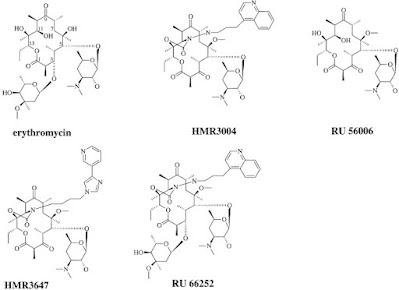Macrolides and Ketolides Antibiotics
These agents are active against some gram-positive bacteria, some gram-negative bacteria, some atypical bacteria, some mycobacteria, and even some spirochetes. But they are not reliably effective against most bacteria in any one group. Nonetheless, they remain very useful agents for the treatment of specific types of infections, such as respiratory infections, and for treatment directed toward specific organisms. The macrolide group of antibiotics consists of erythromycin, clarithromycin, and azithromycin. Telithromycin is a recently approved member of a structurally related class of antibiotics called the ketolides and also will be discussed here.
ACTION
All macrolides consist of a large cyclic core called a macrocyclic lactone ring (hence the name macrolide). This ring is decorated with sugar residues. Macrolides bind tightly to the 50S subunit of the bacterial ribosome at a location that blocks the exit of the newly synthesized peptide. Thus, macrolides function in a manner similar to the aminoglycosides in that they target ribosomes and prevent protein production.
RESISTANCE
Resistance is becoming increasingly common and occurs by one of several mechanisms:
- inhibition of drug entry and accumulation— macrolides have difficulty penetrating the outer membrane of most aerobic gram-negative bacilli and are actively pumped out of some resistant bacteria. For example, some gram-positive bacteria, such as Streptococcus pneumoniae, contain a mef gene that encodes an efflux pump that impairs accumulation of macrolides within the bacterium.
- Enzyme-mediated ribosome binding site alteration—some bacteria acquire resistance to macrolides by methylating the portion of the 50S ribosome normally bound by these drugs, preventing this interaction. For example, this type of resistance is encoded by the erm gene in S. pneumoniae. Methylation of the ribosome in this way also results in resistance to clindamycin and streptogramins, which act by binding the bacterial ribosome and inhibiting protein translation as well.
- Mutation of the ribosome binding site—rarely, mutations occur that affect the portion of the bacterial ribosome bound by macrolides. Regardless of the mechanism, resistance to one member of the macrolide group usually implies resistance to all members.
CLARITHROMYCIN
Clarithromycin is a semisynthetic derivative of erythromycin and also consists of a 14-member macrocyclic lactone ring. It has somewhat greater activity against aerobic gram-positive bacteria and H. infl uenzae than erythromycin.
AZITHROMYCIN
Azithromycin has a modifi ed 15-member macrocyclic lactone ring that allows it to better penetrate the outer membrane of some aerobic gram-negative bacteria. Hence, it has somewhat better activity against these bacteria and is useful in the treatment of H. influenzae. One of its main advantages is that it is taken up in high amounts by tissues and then slowly released over subsequent days. Thus, a 5-day course of oral therapy results in therapeutic drug levels in the blood for 10 days.
TELITHROMYCIN
Telithromycin is the first commercially available member of a new class of antibiotics called ketolides. Ketolides are structurally related to the macrolides but have an expanded spectrum of activity. Telithromycin binds to the same site of the 50S subunit of the bacterial ribosome as the macrolides but has an additional alkylaryl extension, which binds to a second distinct site on the ribosome. Two sites of contact instead of one result in tighter binding and continued interaction even in the presence of some enzymes that methylate the ribosome and result in resistance to macrolides. This tighter binding also limits export of telithromycin by macrolide efflux pumps. Thus, telithromycin is active against many strains of Streptococcus pneumoniae, Staphylococcus aureus, and Streptococcus pyogenes that are resistant to macrolides.
Telithromycin is approved for use in patients with bacterial respiratory infections and has been most carefully studied with organisms that cause these infections. In this context, it is active against most strains of S. pneumoniae, including penicillin-resistant and macrolide-resistant strains. Telithromycin is also active against more strains of staphylococci and other streptococci than are the macrolides, although some strains are resistant because they are capable of modifying their ribosomes in such a way that even telithromycin can no longer bind them. Enterobacteriaceae are resistant to telithromycin, but H. influenzae and Bordetella pertussis are susceptible. The activity of this agent against Neisseria spp. has not been well studied. Many atypical bacteria such as Chlamydia pneumoniae, Mycoplasma pneumoniae, and Legionella pneumophila are susceptible to telithromycin, but its activity against mycobacteria and spirochetes has not yet been defined. Telithromycin is currently only available in an oral formulation.
KEYWORDS
- macrolides and ketolides allergy
- ketolide antibiotics examples
- ketolides side effects
- macrolide antibiotics list
- ketolides mechanism of action
- ketolides uses
LINKS
- https://pubmed.ncbi.nlm.nih.gov/19625112/#:~:text=Macrolides%20and%20ketolides%20are%20two,transferase%20center%20of%2023S%20RNA.
- https://pubmed.ncbi.nlm.nih.gov/15308279/
- https://www.lecturio.com/concepts/macrolides-and-ketolides/
- https://link.springer.com/chapter/10.1007/978-1-4614-1400-1_6
- https://www.sciencedirect.com/topics/medicine-and-dentistry/ketolide
- https://www.rxlist.com/how_do_ketolides_work/drug-class.htm
- https://www.drugs.com/drug-class/ketolides.html
- https://www.clinicalmicrobiologyandinfection.com/article/S1198-743X(15)30105-1/fulltext

%20(1).jpeg)




0 Comments